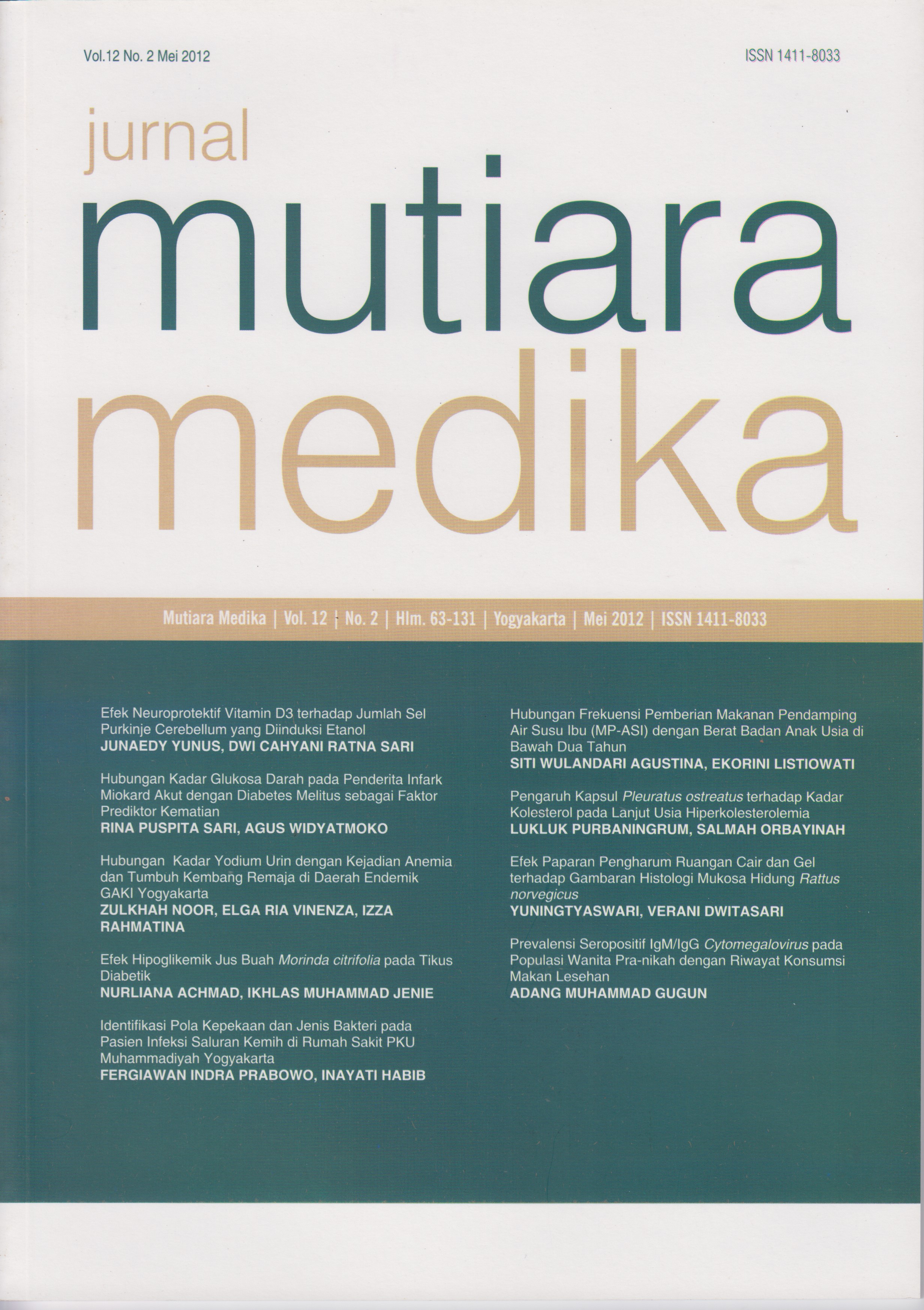Identifikasi Pola Kepekaan dan Jenis Bakteri pada Pasien Infeksi Saluran Kemih di Rumah Sakit PKU Muhammadiyah Yogyakarta
DOI:
https://doi.org/10.18196/mmjkk.v12i2.1009Keywords:
bakteri, pola kepekaan kuman, Infeksi saluran kemih, bacteria, sensitivity pattern, Urinary tract infectionsAbstract
Angka kejadian Infeksi saluran kemih (ISK) di Indonesia masih terbilang tinggi. Resistensi bakteri pada penggunaan antibiotika merupakan salah satu masalah yang berkembang di seluruh dunia. Penelitian ini bertujuan untuk mengetahui jenis bakteri dan pola kepekaannya pada penderita ISK di rumah sakit PKU Muhammadiyah Yogyakarta. Jenis penelitian ini adalah eksperimental laboratorium. Pengukuran dan pengambilan data dilakukan secara cross sectional dan hasilnya dianalisis menggunakan analisis deskriptif. Hasil penelitian menunjukkan 20 pasien yang menderita ISK, didapatkan 25 bakteri antara lain Escherichia coli (72%), Salmonella parathypi (4%), Enterobacter aerogenes (4%), Staphylococcus aureus (8%), Streptococcus sp (12%). Hasil uji sensitivitas terhadap antibiotik didapatkan Escherichia coli sensitif terhadap antibiotik meropenem (88,89%). Salmonella parathypi sensitif terhadap meropenem (100%). Enterobacter aerogenes sensitif terhadap meropenem (100%). Staphylococcus aureus sensitif terhadap meropenem (100%), ciprofloxacin (100%), trimetophrim-sulfomethoxazole (100%), dan gentamicin (100%). Streptococcus sp sensitif terhadap meropenem (66,67%) dan gentamicin (66,67%). Disimpulkan bahwa jenis bakteri yang menjadi penyebab terbesar ISK adalah Escherichia coli. Antibiotik yang memberikan hasil sensitif terbesar terhadap bakteri penyebab ISK adalah meropenem.
In Indonesia the prevalence of urinary tract infections (UTIs) remains high. Bacteria resistance in antibiotic-using is one of the problems that happen in the world. This research aims to know the type of bacteria and its sensitivity pattern in UTIs patient at PKU Muhammadiyah Yogyakarta Hospital. Type of this research is laboratory experimental research. The measurement and data collection done by cross sectional and its result is analyzed by descriptive analyses. This research shows 20 UTIs patients. From 20 samples of UTIs patients, founded 25 bacterium which are Escherichia coli 18 bacterium (72%), Salmonella parathypi (4%), Enterobacter aerogenes (4%), Staphylococcus aureus (8%), Streptococcus sp (12%). The result from sensitivity test toward antibiotic, founded Escherichia coli sensitive toward meropenem antibiotic (88,89%). Salmonella parathypi sensitive toward meropenem (100%). Enterobacter aerogenes sensitive toward meropenem (100%). Staphylococcus aureus sensitive toward meropenem (100%), ciprofloxacin (100%), trimetophrim-sulfomethoxazole (100%), and gentamicin (100%). Streptococcus sp sensitive toward meropenem (66,67%) and gentamicin (66,67%). It was concluded that the most bacteria cause of UTIs is Escherichia coli. Antibiotic that gives the most sensitive result toward the bacteria caused UTIs is meropenem.
References
WHO. (2005). Urinary Tract Infections in Infants and Children in Developing Countries in the Context of IMCI. WHO: Department of Child and Adolescent Health and Development.
Wilianti, N.P. Rasionalitas Penggunaan Antibiotika Pada Pasien Infeksi Saliran Kemih Pada Bangsal Penyakit Dalam Di RSUP Dr. Kariadi Semarang tahun 2008. Laporan Akhir Penelitian Karya Tulis Ilmiah. Semarang: Fakultas Kedokteran Universitas Diponegoro. 2009.
O’Donovan, D, J. (2010). Urinary tract infections in newborns. Epidemiology Urinary tract infection in newborn.
Coyle, EA & Prince, RA. Urinary Tract Infection, in Dipiro J.T., et al, Pharmacotherapy A Pathophysiologic Approach, 6 th , Apleton & Lange, Stamford. 2005.
Hasibuan, H. Pola Kuman Pada Urin Penderita yang Menggunakan Kateter Uretra Di Ruang Perawatan Intensif Dan Bangsal Bedah. Medan: Sub Departemen Bedah Urologi Departemen Ilmu Bedah Fakultas Kedokteran Universitas Sumatera Utara. 2007.
Saepudin, Sulistiawan R,Y., Hanifah S,. Perbandingan penggunaan antibiotika pada pengobatan pasien infeksi saluran kemih yang menjalani rawat inap di salah satu RSUD di Yogyakarta tahun 2004 dan 2006. 2006. Diakses pada 5 Mei 2011 dari http://www.lintas.me/article/journal.uii.ac.id/perbandingan-penggunaan-antibiotika-pada-pengobatan-pasieninfeksi-saluran-kemih-yang-menjalani-rawatinap-di-salah-satu-rsud-di-yogyakarta-tahun2004-dan-2006/1
Paramita, L. Pola kepekaan bakteri penyebab infeksi saluran kemih terhadap beberapa antibiotika di laboratorium mikrobiologi Fakultas Kedokteran Universitas Gadjah Mada. Karya Tulis Ilmiah. Yogyakarta: Fakultas Kedokteran Universitas Gadjah Mada. 2006.
Helmansyah, R. Pola Kepekaan Bakteri Isolat Urin Di RSU PKU Muhammadiyah Yogyakarta Tahun 2003-2006. Karya Tulis Ilmiah. Yogyakarta: Fakultas Kedokteran dan Ilmu Kesehatan Universitas Muhammadiyah. 2006.
Jawetz, M & Adelberg. Mikrobiologi Kedokteran edisi 23 alih bahasa hartanto, huriawati, dkk. Jakarta: Penerbit buku kedokteran ECG. 2004.
Katzung, G.B. Farmakologi Dasar dan Klinik Edisi IV. Jakarta: EGC. 1995.
Downloads
Published
Issue
Section
License
Copyright
Authors retain copyright and grant Mutiara Medika: Jurnal Kedokteran dan Kesehatan (MMJKK) the right of first publication with the work simultaneously licensed under an Attribution 4.0 International (CC BY 4.0) that allows others to remix, adapt and build upon the work with an acknowledgment of the work's authorship and of the initial publication in Mutiara Medika: Jurnal Kedokteran dan Kesehatan (MMJKK).
Authors are permitted to copy and redistribute the journal's published version of the work (e.g., post it to an institutional repository or publish it in a book), with an acknowledgment of its initial publication in Mutiara Medika: Jurnal Kedokteran dan Kesehatan (MMJKK).
License
Articles published in the Mutiara Medika: Jurnal Kedokteran dan Kesehatan (MMJKK) are licensed under an Attribution 4.0 International (CC BY 4.0) license. You are free to:
- Share — copy and redistribute the material in any medium or format.
- Adapt — remix, transform, and build upon the material for any purpose, even commercially.
This license is acceptable for Free Cultural Works. The licensor cannot revoke these freedoms as long as you follow the license terms. Under the following terms:
Attribution — You must give appropriate credit, provide a link to the license, and indicate if changes were made. You may do so in any reasonable manner, but not in any way that suggests the licensor endorses you or your use.
- No additional restrictions — You may not apply legal terms or technological measures that legally restrict others from doing anything the license permits.



